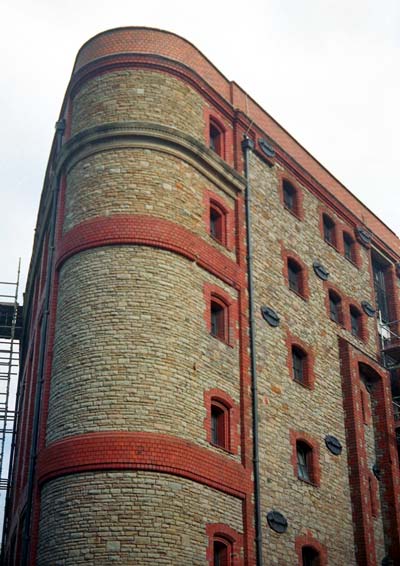Balda Poka Duplex
Specification
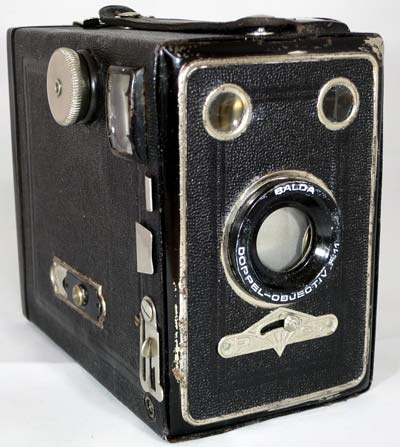
| Manufacturer | : | Balda |
|---|---|---|
| Produced | : | 1934 |
| Classification | : | Medium Format |
| Body Type | : | Box |
| Construction | : | Metal |
| Film Type | : | 120 |
| Film Width | : | 62mm |
| Image Size | : | Dual Format 6x9 & 4x6 cm |
| No. of Images | : | 8/16 |
| Lens Type | : | Doppel Objectiv (double) |
| Focus Type | : | Fixed |
| Focal Length | : | 110mm |
| Focus Range | : | 4m to inf. + Portrait |
| Aperture Type | : | Variable stops |
| Aperture | : | f/11, f/16 |
| Shutter Type | : | Rotary |
| Shutter Speeds | : | B,I*(1/30 sec) |
| Size (w x h x d) | : | 80 x 110 x 125 mm |
| Weight | : | 412g |
| * Measured on this camera | ||
Art Deco Credentials
![]()
![]()
![]()
Noteworthy: Worth giving special attention
- Produced during the main Art Deco period;
- Each face embossed with rectangular pattern;
- Decrorative chrome focus plate on front;
- Chrome border around the front panel;
- Chrome circles around lens and viewfinders.
- Grooved leather strap;
- Bright metal winder.
Description
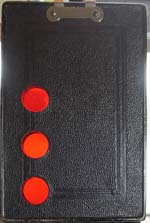
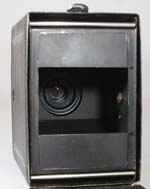

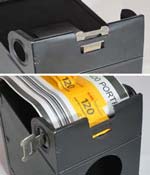
The Balda Poka Duplex is an enhanced version of the Balda Poka II. It's distinguishing feature is its ability to change the image format mid-roll without opening the camera. There is a sliding switch located on the left hand side which allows the user to choose a 9x6cm or a 4x6cm format. When the switch is moved, internal baffles are swung into place to give the 4x6cm format. This is an improvement on the normal arragements for cameras with dual formats in which a mask has to be inserted in the camera to get the smaller format. Once in position, the format must stay the same for the whole roll. The advantage of choosing the 4x6cm format is that you can get 16 images on a roll rather than 8 when using it in 9x6cm format. In order that the user can change format mid-roll without image overlap, there are 3 red windows on the rear of the camera. Choosing the correct red window to use at any time is important.
This version of the Poka is made of metal and has a two-element f/11 lens. One of two aperture values (f/11 or f/16) can be chosen by pulling on a tab on the side. It will normally focus over the range 4m to infinity but a switch on the front gives the option of portrait mode in which a portrait lens is swung into position, changing the focussing range to 1m to 3m.
The shutter is a simple B/I shutter giving instantaneous mode and a timed mode. It is possible to lock the shutter when using it in time mode. There also is a cable release socket.
Two brilliant finders are provided for both landscape and portrait mode. The viewfinders have markers to show the image size when 4x6cm is selected. There are two tripod mounts.
A fairly unique feature of this and other Balda box cameras is the provision of a special key to aid the loading of the film. The key is held in a slot to avoid losing it. It is used to advance and secure the film onto the spool before inserting the film carrier into the camera. Rather neat I think.
How to Use
This camera takes 120 film which is easily available.
Film Transport
When using 6x9 format, then simply use the middle red window. When using 4x6 format, the bottom and top red windows are used. Line up the next frame number in the bottom window and take a snap. Then line up the same number in the top window and take a snap. Move on to the next frame number in the bottom window again and continue alternating between the bottom and top windows for the next shots.
If you change to 6x9 mid film, use the middle window for the next frame number and continue to use the middle window for subsequent shots. If you change to 4x6 mid film, revert back to the bottom window for the next frame number then continue alternating between the bottom and top windows for the next shots.
Exposure
As the shutter speed is only 1/30s, it is advisable to use a tripod to get clear shake free images. However, holding it against a wall or other solid object would work as well. For quick snapshots, hold it firmly against your body.
If you don't want to bother with an exposure meter, follow the guide shown. It is based on the 'Sunny 16' rule. Film is so forgiving and will produce acceptable results even when overexposed by 2 or 3 stops or underexposed by 1 stop.
The tables assume that the sun is at least 30 degrees above the horizon - that's 10am - 5pm on a summers day (May - August) in the UK.
Remember that the exposure guide in the manual may not be helpful as it is based on the use of old film with a low ISO value.
Using ISO 100/125 film - shutter speed 1/30s
| Weather Conditions | Shadow Detail | Aperture | Exposure |
|---|---|---|---|
 Sunny SunnySnow/Sand | Dark with sharp edges | f/16 | +3 Stops Overexposed Acceptable |
 Sunny Sunny | Distinct | f/16 | +2 Stops Overexposed Acceptable |
 Slight Overcast Slight Overcast | Soft around edges | f/16 | +1 Stop Overexposed Acceptable |
 Overcast Overcast | Barely visible | f/16 | Good |
 Heavy Overcast Heavy Overcast | None | f/11 | Good |
 Open Shade Open Shade/Sunset | None | f/11 | -1 Stop Underexposed Acceptable |
Photographs taken with this Camera
Kodak Ektar 100 film. Developed in Tetenal

